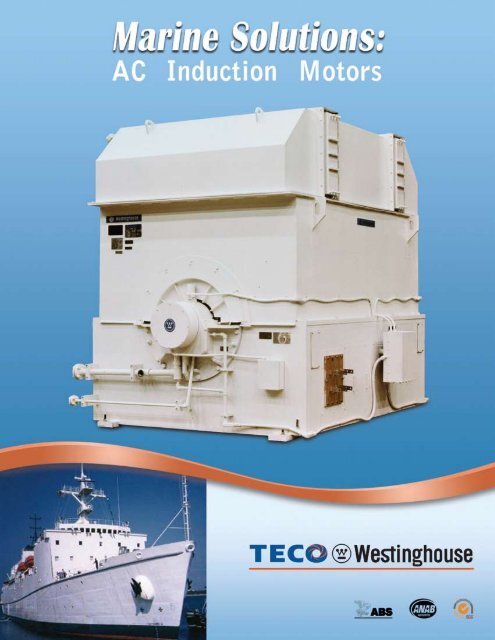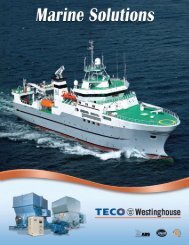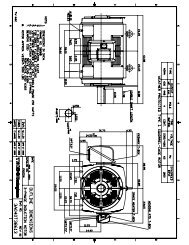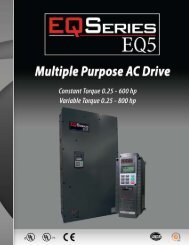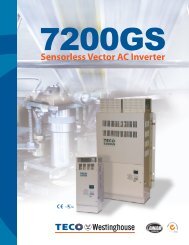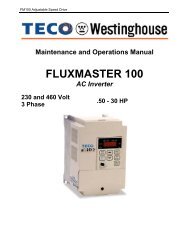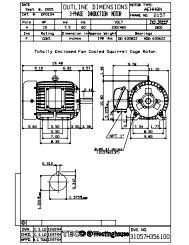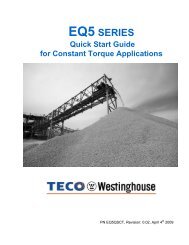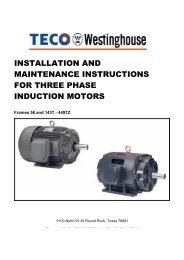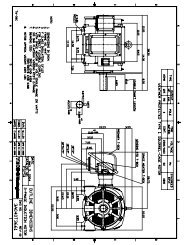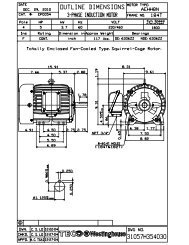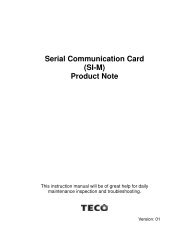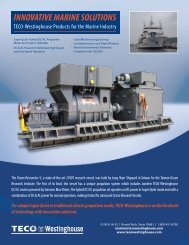Marine Induction Motors - TECO-Westinghouse Motor Company
Marine Induction Motors - TECO-Westinghouse Motor Company
Marine Induction Motors - TECO-Westinghouse Motor Company
You also want an ePaper? Increase the reach of your titles
YUMPU automatically turns print PDFs into web optimized ePapers that Google loves.
<strong>Marine</strong> <strong>Induction</strong> <strong><strong>Motor</strong>s</strong><br />
A Proud Tradition of Leadership<br />
<strong>TECO</strong>-<strong>Westinghouse</strong> <strong>Motor</strong> <strong>Company</strong> began a tradition of industry leadership in 1884 when company founder<br />
George <strong>Westinghouse</strong> and Nicola Tesla introduced the world’s first line of commercially practical polyphase<br />
induction motors. This pioneering achievement launched a new era in the utilization of electrical energy and<br />
we have continued to be an industry leader in electric motor design and manufacturing. Responding to the<br />
growing demands of industry, we have developed several generations of large-scale induction motors, each<br />
setting new standards for performance and reliability. These advances, along with the advent of the adjustable<br />
frequency drive, have culminated with our modern <strong>Marine</strong> family of motors.<br />
Factory Then<br />
A Distinguished Record of Innovation<br />
Factory Now<br />
TWMC’s position as a world leader in the design and manufacture of large induction motors is secured by<br />
an unfailing commitment to engineering excellence and technological innovation. Among our most notable<br />
pacesetting advances, in addition to the induction motor itself, are the Thermalastic® Epoxy Insulation system,<br />
refinements in copper bar rotor construction, and high frequency induction brazing. Much of our success<br />
results from an emphasis on computer-aided design as a tool for engineering excellence. Drawing on more<br />
than four decades of design related computer analysis techniques, we optimize the design of every motor.<br />
These experience-based computer capabilities account for the high levels of performance and refinement that<br />
characterize the marine series induction motors.<br />
TWMC marine application motors are specifically designed to meet IEC 60034-18-41/42 and can be used with<br />
any quality adjustable frequency drive. These motor designs also meet any of the major marine classification<br />
specifications, including ABS, DNV, LLOYDS, etc.
<strong>Marine</strong> <strong>Induction</strong> <strong><strong>Motor</strong>s</strong><br />
Propulsion Drive System Options<br />
Our induction motors are typically used for the following marine applications: direct drive, geared drive, thruster<br />
drive, water jet drive, and pod drive. They can also be used in a hybrid drive where the motor drives into a<br />
gearbox and is in parallel with a mechanical propulsion prime mover such as a large diesel or gas turbine. This<br />
motor provides efficient low power for slower ship speed operation.<br />
<strong>Motor</strong> Configurations<br />
TWMC induction marine motors can be either bracket type or pedestal type. Bracket type motors feature a<br />
common rugged fabricated steel housing for the stator and bearing assemblies. Pedestal type motors have a<br />
free standing stator assembly and free standing bearing assemblies that are mounted on a common base plate<br />
structure which is mounted to the ship’s hull. Larger motors are typically pedestal type. In either configuration,<br />
the motor ventilation system is a subassembly mounted on top of the motor.<br />
Bracket <strong>Motor</strong><br />
Pedestal <strong>Motor</strong>
Excellence in Design & Manufacturing<br />
TWMC has worldwide engineering, manufacturing, and R&D capabilities. The key to high efficiency levels of our<br />
marine motors is our ability to draw on our cumulative past experience to determine the precise combination<br />
of design variables that best meet customer specifications. Our engineers are able to review hundreds of<br />
design configurations in minutes, making it feasible to explore a complete range of possibilities and ultimately<br />
to optimize each design. State-of-the-art software capabilities also enable us to provide superior designs,<br />
drawings, complete quotations, and accurate performance data. TWMC also has an experienced R&D<br />
engineering team to support our design engineering staff for optimizing electromagnetic designs, mechanical<br />
designs, ventilation design, stress analysis, and vibration analysis.<br />
<strong>TECO</strong>-<strong>Westinghouse</strong> has three large modern manufacturing facilities in addition to our factory headquarters<br />
in Round Rock, Texas. Each of these factories has the ability to manufacture the same large motor designs at<br />
the same quality level.<br />
Round Rock Headquarters<br />
Engineering Design Center<br />
Factory View
Heavy Duty Rotor Construction<br />
<strong>Induction</strong> Rotors<br />
<strong>Motor</strong> rotor<br />
laminations are thin sheets of precoated electrical steel. Each<br />
lamination is coated with a special insulating material that<br />
forms a molecular bond with the lamination metal to achieve<br />
interlaminar resistance. Core losses are minimized because<br />
the coating will not flow at any operating temperature, will not<br />
interact with other insulating materials, varnishes, or paints,<br />
and is not affected by moisture. The lamination bore, OD, and<br />
slots are punched utilizing special dies to assure accuracy and<br />
minimum burr height.<br />
One of the keys to the reliability of TWMC’s marine duty motors<br />
is our emphasis on superior rotor design and construction.<br />
The shaft is machined from a carbon steel forging designed for<br />
the rigors of marine propulsion service and to meet the marine<br />
codes. It features a smooth finish and specific contours to<br />
assure minimum stress concentrations. Smaller motors have<br />
radial arms that are integral with the shaft for transmitting<br />
torque from the laminated core. Larger motors have a fabricated<br />
steel spider structure that is shrunk to the shaft with heavy<br />
interference.<br />
Swaged<br />
Rotor<br />
Bar<br />
Special vent plates and fingerplates are used to allow ventilating<br />
Swaged Rotor<br />
air to pass radially through the laminations, thus assuring<br />
optimum heat transfer. These components also act like<br />
fans to assure uniform distribution of ventilating air<br />
within the motor.<br />
The rotor core is clamped between endplates and<br />
core pressure is maintained with thru studs. The core<br />
mechanical integrity does not rely on any electrically<br />
active component. The rotor core assembly is then<br />
shrunk onto the spider arms.<br />
Rotor Brazing<br />
The rotor bars and end rings are made of copper, which<br />
has high conductivity and thermal capacity. The bars and<br />
end rings are sized similar to those used on “across the<br />
line start” motors, providing high strength and stiffness<br />
for marine service. End rings are centrifugally cast to<br />
assure purity and a void-free cross section. The bars and<br />
rings are machined to provide a special joint configuration<br />
and then joined together with a high frequency induction<br />
brazing process to assure high strength, reduce stresses,<br />
and eliminate hot spots in the joint. The rotor bars are<br />
then swaged with a special process that eliminates bar<br />
movement and vibration that can result in bar fatigue<br />
and failure.
Stator Construction<br />
TWMC induction motors are available in two types of stator construction. Smaller motors utilize bracket type<br />
construction which features a heavy duty steel fabricated box with the stator frame and bearing assemblies<br />
integral with it. The fabricated steel frames are braced by steel plate bulkheads for lateral and torsional stability.<br />
End brackets are reinforced to give the bearings rigid support and to reduce vibration. Overall frame strength<br />
also minimizes vibration and virtually eliminates the need for realignment. The motor mounts directly to the<br />
hull.<br />
For larger motors, the stator frame and bearing pedestals are mounted to a bedplate, which is mounted to<br />
the hull of the ship. For both pedestal and bracket construction motors, the ventilation package is typically<br />
mounted on top of the motor as a subassembly. The air ventilation subassembly can be mounted remotely<br />
from motor when there is restricted engine room space.<br />
The stator core is assembled from stacks of individual thin laminations made of precoated electrical steel and<br />
clamped by large end rings with thru studs providing the clamping force. The core is welded into the frame for<br />
rigidity. Stacked into the core are vent plates which provide radial flow paths around the stator coils to transfer<br />
their heat to the ventilating air.<br />
Rugged<br />
Frame<br />
Construction<br />
Thermalastic Expoxy Insulation<br />
Advanced Bearing Design<br />
Heavy Duty Copper
Windings<br />
The TWMC Thermalastic® Epoxy Insulation system is a patented process that ensures the unsurpassed<br />
dielectric strength and voltage endurance for marine motors. Mica is the key to the Thermalastic® insulation<br />
system and is used for all stator coils. The coils fit in the slots of the stator and are then wedged. The end turns<br />
are braced to prevent coil motion both from motor magnetic forces and against dynamic ship motion forces.<br />
Coil Bracing and Wedging<br />
When the stator winding components are fully installed, including the insulated coils, coil-to-coil connections,<br />
and winding supports, the entire stator is post-impregnated with solventless epoxy resin in a vacuum pressure<br />
tank. The stator is then transferred to an oven for polymerization. This vacuum pressure impregnation (VPI)<br />
cycle is repeated for the elimination of corona-generating voids. The result is a reliable insulation system<br />
capable of withstanding prolonged voltage stresses, thermal cycling, moisture, and dirt.<br />
VPI Process
Bearings<br />
Two types of bearings are available with our marine motors. Most smaller motors are supplied with long life<br />
antifriction bearings that are grease lubricated. The aft bearing has limited end float and maintains rotor<br />
position. This can be either a split roller bearing or a deep groove ball bearing with preloading springs. The<br />
upper bearing on vertical motors supports not only the rotor weight but also the dynamic ship motion forces.<br />
Antifriction bearings can also be oil lubricated.<br />
Large motors are typically supplied with sleeve bearings that are disc lubricated and self contained. In some<br />
cases, it may be necessary to provide a lubrication system for the bearings. For applications requiring very low<br />
speed operation for an extended period of time, hydrostatic lift can be supplied at each bearing.<br />
TWMC can also provide a heavy duty thrust bearing as one of the main motor bearings. This bearing can<br />
handle the propeller thrust in both directions.<br />
Renk Sleeve Bearing<br />
<strong>Motor</strong> with Anti-friction Bearing<br />
<strong>Marine</strong> Disc Lube Thrust Bearing
Ventilation<br />
Force Ventilated Enclosure<br />
TEWAC Enclosure<br />
A variable speed propulsion motor must be capable of operating with full torque at zero speed. As a result,<br />
marine motors require a ventilation system independent of the main motor speed.<br />
There are three types of ventilation systems normally used for marine motors:<br />
• Type one has the ventilation air piped into the motor from a separate source.<br />
• Type two has a separate fan with a motor mounted on top of the marine motor. The fan can obtain its air<br />
from another compartment in the ship or from the engine compartment.<br />
• The third type is commonly used and is known as the totally enclosed water to air cooled (TEWAC). The<br />
requirement of a TEWAC is to have a separate complete ventilation subassembly mounted on top or along<br />
side the motor. This subassembly includes an air to water heat exchanger and separate motor driven<br />
blowers. This system provides a closed loop system independent of the environment. The heat exchanger<br />
can use either fresh water or sea water and is typically fitted with a water regulating valve in the water<br />
piping. This valve controls the water flow as a function of the air temperature in the motor which assures<br />
that condensation will not occur in the motor.<br />
Vertical <strong><strong>Motor</strong>s</strong><br />
<strong>TECO</strong>-<strong>Westinghouse</strong> marine vertical motors reflect the same high<br />
quality construction and insulation processes that distinguish all<br />
the various components of our horizontal motors. Our vertical<br />
motors are readily adaptable to a variety of specific needs.<br />
Vertical <strong>Motor</strong><br />
Vertical <strong><strong>Motor</strong>s</strong>
Low Voltage <strong><strong>Motor</strong>s</strong><br />
In addition to large propulsion motors, TWMC stocks a complete line of auxiliary inverter duty motors from 1<br />
HP to 800 HP. These motors are used for propulsion fans, pumps, compressors, and other applications aboard<br />
the ship. All low voltage motors are rugged duty motors specifically designed for marine applications (above<br />
and below deck requirements) and meet the major marine codes, such as ABS. In addition they meet IEEE45<br />
marine duty specifications.<br />
Low voltage motor features include:<br />
• Totally enclosed fan cooled construction<br />
• Premium efficiency<br />
• 1.15 continuous service factor<br />
• Class B temperature rise- Class F insulation<br />
• Bi-directional rotation<br />
• 2 – Part Epoxy paint system<br />
• Stainless steel nameplates, hardware and breather drains<br />
• Noise level less than 85 db (A) at 1 meter<br />
• INPRO seals on both ends<br />
Low Voltage Inverter Duty <strong>Marine</strong> <strong>Motor</strong> Cutaway<br />
Drives<br />
<strong>TECO</strong>-<strong>Westinghouse</strong> <strong>Motor</strong> <strong>Company</strong> supplies low voltage AC drives from 5 HP to 500 HP (3 to 373 kW) for your<br />
marine duty applications. These drives comply with the major world marine codes, including ABS, etc.<br />
<strong>Marine</strong> Duty Low Voltage AC Drive Features:<br />
• Remote Analog Operator<br />
• Either LED or LCD Digital Operators<br />
• Output Card<br />
• PID Relay Card<br />
• Various Communication Cards Available<br />
• Energy Saving Software<br />
• Computer Link Software<br />
• PID sleep Mode Function<br />
<strong>Marine</strong> Duty Low Voltage Drive
<strong>Marine</strong> Standard Capabilities<br />
3 Phase Windings<br />
< 1000 VAC 500 – 5000 HP 100 – 1800 RPM<br />
2400 - 4160 VAC 1000 – 14,000 HP 100 – 1800 RPM<br />
6000-13,800 VAC 2000 – 26,000 HP 100 – 1800 RPM<br />
Multi - Phase Windings<br />
< 1000 VAC 500 – 8000 HP 100 – 1800 RPM<br />
2400 - 4160 VAC 1000 – 20,000 HP 100 – 1800 RPM<br />
6000-13,800 VAC 2000 – 35,000 HP 100 – 1800 RPM<br />
Other Voltage, Rating and Speed combinations are available.<br />
Service<br />
At <strong>TECO</strong>-<strong>Westinghouse</strong> <strong>Motor</strong> <strong>Company</strong>, we pride ourselves on service. Our valued customers are able to tap<br />
into the strength of our resources for superior front end services, including engineering support, computer<br />
studies, product information and quotation assistance. Once your marine motor is in place, you can rely on our<br />
worldwide field service and engineering network to service and protect your investment.<br />
<strong>Induction</strong> motor testing
LM-MSAC 02/08


